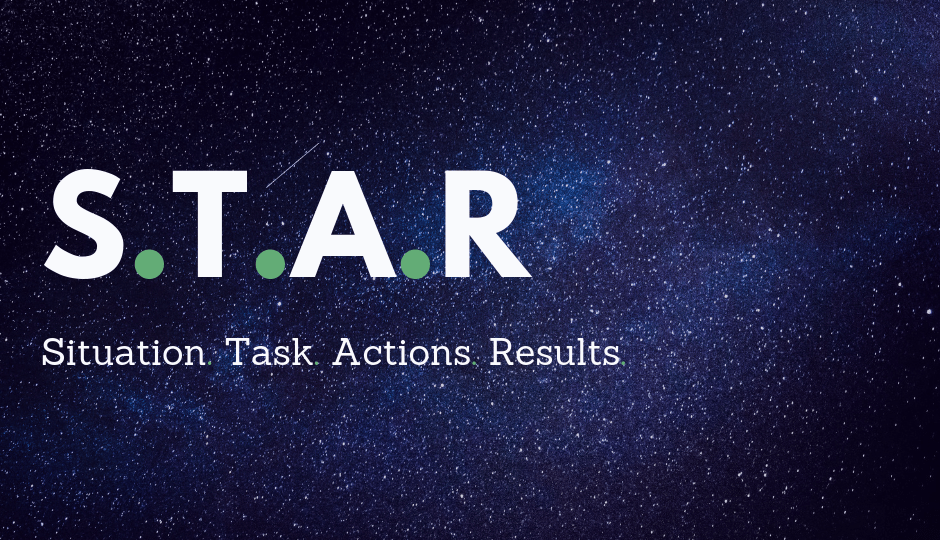If you’ve been doing some internet research for your upcoming interview, you’ve probably heard of the STAR method. In this article, we’ll dive into the STAR method and explain what it is, and how to implement it in your interview answers, and give you some examples.
What is the STAR method?
“STAR” is actually an acronym in this case and is centered around four techniques that each of your interview answers should. It stands for Situation, Task, Actions, and Results. The STAR method is normally used during behavioral-type questions. To break that down for you, each answer should include these four things:
Situation
First, your answer should start off with a situation in which you had in the past. It’s best to use a previous work situation, but if you don’t have any, you can use any type of difficult situation really.
Task
Once you’ve explained the situation, you then need to explain the tasks in which you were personally responsible for.
Actions
This is the time to explain the specific actions you took in order to complete these tasks. Try not to be vague during this part. If you can, walk your interviewer step-by-step with each action you took. The more detailed, the better.
Simulate your next interview
Prepare for the questions that are really going to be asked in your next interview.
Results
Here’s where you wrap it all up and explain how your actions helped solve that particular situation. In some cases, you could even show how your actions didn’t solve the situation and explain what exactly you learned from it.
STAR Interview Questions & Answers Examples:
Let’s walk through an interview question and answer it using the STAR method.
Question:
Explain a difficult situation you’ve had at work and how you solved it.
Answer:
“There was one situation where I really believed that our company should offer a free trial to our users. My boss (and owner of the company) did not believe that this was the best thing for us to do and didn’t think we should spend the time and resources on implementing it unless we had a good reason. I spent the next couple of days implementing Hotjar (a popular analytics tool) so that I could watch users navigate our website. I had many recordings of users getting all the way to the checkout page and then stopping all of a sudden and left the website. I then installed a survey form that would pop-up just as a user was about to leave that page and would ask them why they weren’t finishing the signup page. One of the options was “I thought there would be a free trial”. We had an overwhelmingly amount of people answer this option. I was able to present these results to my boss and show him, with data, that users were expecting a free trial and were leaving once they realized there wasn’t one. My boss agreed to begin testing free trials on the website and within the first month of launching free trials, we had a 5% increase of registrations.”
STAR Interview Answer Breakdown
Now, let’s walk through this answer and breakdown how the STAR Method was approved here:
Situation:
“There was one situation where I really believed that our company should offer a free trial to our users. My boss (and owner of the company) did not believe that this was the best thing for us to do and didn’t think we should spend the time and resources on implementing it unless we had a good reason.”
In this part of the answer, the situation was clearly stated. I wanted to implement free trials and my boss, who had the final say, did not.
Tasks:
“My boss (and owner of the company) did not believe that this was the best thing for us to do and didn’t think we should spend the time and resources on implementing it unless we had a good reason to”
The very last part of this sentence, “unless we had a good reason to”, clearly states what my task was. I had to provide a “good reason” if I ever wanted us to implement free trials.
Actions:
“I spent the next couple of days implementing Hotjar, a popular analytics tool, in order to watch users navigate our website. I had many recordings of users getting all the way to the checkout page and then stopping all of a sudden and left the website. I then installed a survey form that would pop-up just as a user was about to leave that page and would ask them why they weren’t finishing the signup page. One of the options was “I thought there would be a free trial”.
Here, I walked through the exact actions that I took in order to provide a good reason for my boss. I even mentioned the exact tools I used to perform those actions.
Results:
“We had an overwhelmingly amount of people answer this option. I was able to present these results to my boss and show him, with data, that users were expecting a free trial and were leaving once they realized there wasn’t one. My boss agreed to begin testing free trials on the website and within the first month of launching free trials, we had a 5% increase of registrations.”
Finally, I used specific results with data and concluded the situation with a happy ending. Of course, these types of answers don’t always have to be some great success story. It’s possible to still present yourself as a great candidate by explaining a situation that didn’t have a great outcome.
Practice STAR Interview Questions & Answers.
Start Practicing Interview Questions Now!
According to Glassdoor, every corporate job attracts 250 applicants on average. Gain an edge over these other applicants by learning from previous interviewees.
Create a free account at Interview School and start practicing behavioral questions where you can apply the STAR interview method!




